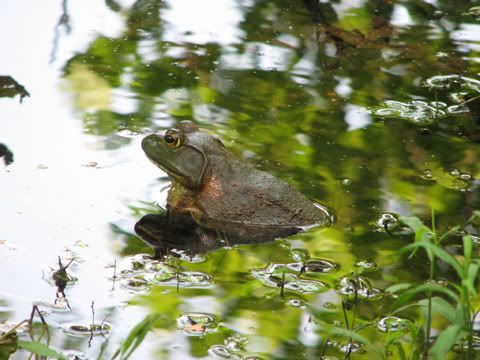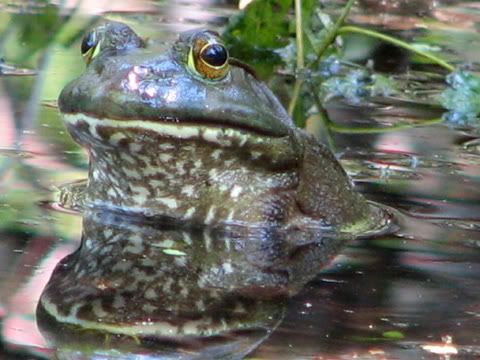365 Urban Species. #171: Bullfrog

Photo by cottonmanifesto. Location: Scarboro Pond, Franklin Park, Boston.
Urban species #171: North American Bullfrog Rana catesbeiana
A close comparison between the bullfrog and the common snapping turtle is compelling to me. Both are the largest of their kind in New England--no other local amphibian comes close to the full pound that a large bullfrog might weigh. They're both ambush predators--though bullfrogs are far more aggressive, and able to prey on animals nearly their own size. And they are both animals that become more common after humans change the landscape.
Bullfrogs tolerate a wide range of water pH, including the acid conditions found in urban ponds. They are more tolerant of pollutants than most amphibians, a group of animals that has permeable skin that allows toxins from the water and air to pass into their bodies. Bullfrogs also have a history of being introduced into new places, either by accident, or to be used as a food animal. When bullfrogs enter an ecosystem that is new to them, they often become a major threat to native frog species and other animals. Not only do they feed on other frogs, but they are known to carry diseases that impact other frogs more strongly than bullfrogs.
Bullfrogs are surprisingly long-lived. They survive as tadpoles, legless larvae that scavenge on aquatic plants and carrion, for two winters. It takes them another two to three years to reach sexual maturity. The male's basso profundo mating call is a sign of summer on the urban pond. The female can deposit up to 20,000 eggs at a time, most of which will be eaten by fish, turtles and other animals. The few that survive to become tadpoles, and then frogs, may live up to ten years.
